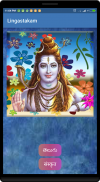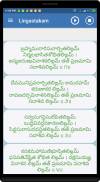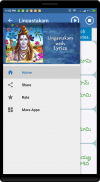







Lingastakam

Mô tả của Lingastakam
A short introduction
Lingashtakam is a hymn in praise of Sri Siva, also called Maheswara, Rudra, Pasupati etc. The Linga is a symbol for Siva, just like Sankha and Chakra are symbolic of Sri Vishnu. Linga also means the gender of a being. We have Stree Linga (Female gender), Pumlinga (Male Gender) and Napumsaka Linga (literally non-male Gender, but meaning neutral gender). Linga has also become over the ages, a symbol of manliness, the erect phallus, and it is appropriate since He is the Adi Purusha. While Para Brahma is considered to be Nirguna, i.e. without any discernible attributes, once He/She/It decides to manifest in Saguna form (for reasons beyond our intelligence), we have Purusha (male) and Prakriti (Nature, considered to be feminine). And we have the Trinity (the creating, preserving and destroying aspects) of Devas and Devis, Brahma, Vishnu and Siva in the male aspects and Saraswati, Lakshmi and Parvati in their female aspects, their consorts.
Một giới thiệu ngắn
Lingashtakam là một bài thánh ca ca ngợi Sri Siva, cũng gọi là Maheswara, Rudra, Pasupati vv Linga là biểu tượng cho thần Siva, giống như Sankha và Chakra là biểu tượng của Sri Vishnu. Linga cũng có nghĩa là giới tính của một con người. Chúng tôi có Stree Linga (Nữ giới), Pumlinga (Nam giới) và Napumsaka Linga (nghĩa đen phi nam giới, nhưng có nghĩa là giới tính trung lập). Linga cũng đã trở thành qua các thời đại, một biểu tượng của sự nam tính, những cái dương vật cương cứng, và nó là phù hợp vì Ngài là Adi Purusha. Trong khi Para Brahma được coi là Nirguna, nghĩa là không có thuộc tính nào rõ rệt, một khi Ông / Bà / Nó quyết định biểu hiện ở dạng Saguna (vì lý do ngoài sự thông minh của chúng tôi), chúng tôi có Purusha (nam) và Prakriti (Nature, được coi là nữ tính ). Và chúng tôi có Ba Ngôi (các tạo, bảo quản và tiêu diệt các khía cạnh) của chư Thiên và Devis, Brahma, Vishnu và Siva trong những khía cạnh nam và Saraswati, Lakshmi và Parvati trong khía cạnh nữ của họ, phu nhân của họ.























